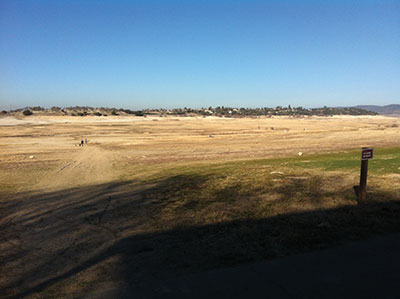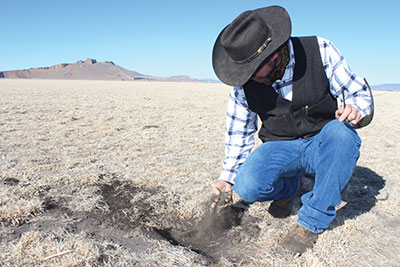
Features
Sustainability
Water Issues
Dry, Drier, Driest
How ground water is saving California farmland
September 2, 2014 By Carolyn Camilleri
With farmers losing crops, workers losing jobs, and statewide mandatory conservation, news reports about the California drought present a dire picture that seems to be getting worse by the day.
With farmers losing crops, workers losing jobs, and statewide mandatory conservation, news reports about the California drought present a dire picture that seems to be getting worse by the day.
 |
|
| Folsom Lake, one of the reservoirs that serve as a source of water for the local water districts and provides environmental flows on the Lower American River. This photo was taken in January. Photo courtesy of West Yost Associates Advertisement
|
“The drought is as bad as it can possibly be at this point in time,” says James Famiglietti, senior water scientist and professor at University of California, Irvine. “With minimal rainfall and snow this year and the drought, it’s shaping up to be the worst year since record-keeping began in the late 1800s.”
Understanding the severity of the situation means first understanding what is normal.
“In an average rainfall year, roughly 40 per cent of the state’s overall water needs are met by ground water,” says Dave Kranz, communication and news division manager for the California Farm Bureau Federation. “In dry years such as this one, that percentage can climb closer to 60 per cent.”
However, the current situation is not just a dry year; Kranz says 2014 is the driest year in recorded California history, coming hard after a winter that was among the driest with two previous sub-par years before that.
“As a result of that, and of environmental regulations that require more water in streams to be dedicated to fisheries protection, the reservoirs that serve our surface-water systems have been drawn down,” says Kranz.
With surface-water deliveries restricted, farmers have turned to ground water as a supplemental supply and, in many cases, that means new wells and deeper wells.
“The backlog of drilling projects has hit an all-time high, with waiting lists ranging from three to 18 months, depending on the well depth and production,” says John Hofer, executive director of the California Groundwater Association. “Since most of the deep wells involve agricultural developments, they make up the majority of the backlogged work.”
With agriculture relying almost exclusively on wells, aquifer storage levels are declining. Though most of the draw is from agriculture, urban areas are also relying more heavily on ground water, says Famiglietti. “Right now we are relying on ground water to provide roughly 75 per cent of our region’s water supply.”
Famiglietti adds that farmers don’t have much choice but to drill wells. “Until we get some better management of ground water resources in place that might slow the rates of decline, short of pulling land out of production or quitting altogether, the individual farmer has limited options.”
The enormity of California’s agricultural sector was revealed in a report released on July 15 from the University of California. It states that the direct cost of the drought to agriculture is $1.5 billion, a huge figure that represents a net revenue loss of three per cent of the state’s total agricultural value. Similarly, 17,100 seasonal and part-time jobs related to agriculture have been lost, representing 3.8 per cent of farm unemployment. And finally, 428,000 acres of irrigated cropland is going out of production due to the drought — or five per cent of cropland.
Looked at only as percentages, it appears that California’s agricultural economy is weathering the drought.
“California’s agricultural economy overall is doing remarkably well, thanks mostly to ground water reserves,” said Jay Lund, a co-author of the study and director of the university’s Center for Watershed Sciences. “But we expect substantial local and regional economic and employment impacts.”
While the university’s report indicated that food prices would be “largely unaffected,” this may also be a case of a percentage perspective.
“Water intensive crops like rice, which require flood irrigation, were the first to experience rising prices due to the shortage of water and higher price per acre foot,” says Famglietti. “We can’t grow food without water. I fully expect to see great increases in food prices that will have ripple effects throughout the economies of the North American countries and perhaps beyond.”
Meanwhile, legislation for ground water management is being considered –and what that legislation is going to look like is raising concerns.
Chris Petersen, vice president of the Groundwater Resources Association of California, says that, in general, the CGA supports the concept of local ground water management, recognizing the many success stories among local agencies.
“When you have a local or regional agency that is actively managing the ground water basin, it is the best way to go,” says Petersen. “What we don’t want to have happen is for the state to come in and take that control away from the locals, especially in those basins where the locals are doing a good job managing the resource.”
The state, says Petersen, is never going to have the staff or resources to understand and manage the basins as well as the local agencies. Kranz agrees, saying that the Farm Bureau worries about efforts to impose any sort of statewide regulation because of the great variation among the hundreds of basins in the state.
An issue that both Petersen and Kranz identify is that some areas have not established effective ground water governing agencies.
“It is those basins that are experiencing problems and the problems are much more exaggerated with the drought, and because of that, there is a need for someone to step in,” says Petersen. “Ideally, it is the local or regional agency stepping up and getting the job done, but without that, it is becoming pretty clear that we need some sort of back stop.”
Petersen says that, for years, the local agencies were united against the state controlling ground water management. Now that there is so much competition for water, some of the local agencies are asking the state to referee. In other areas, ground water stakeholders are asking for help with contamination and water quality problems. Petersen says the GRA is hopeful that, rather than control, the state can provide support, education and even grants to help locals better manage their resources.
But much more is needed.
 |
|
| News reports about the California drought present a dire picture that seems to be getting worse by the day. Photo courtesy of California Farm Bureau Federation |
“Farm Bureau strongly believes ground water problems in California would be minimized if we would deal with a longstanding failure to update the state’s woefully inadequate system for capturing and delivering surface water,” said Danny Merkley, a water policy specialist for the Farm Bureau Federation, in a Farm Bureau report issued on June 25.
Petersen believes new surface infrastructure will help but it isn’t the whole solution. “We need to increase storage for both [surface and ground water] especially in light of climate change,” he says.
Famglietti also discusses climate change. “In the short term, we can only hope for some wet winters over the next few years,” says Famglietti. “In the long term, the best available science points to long-term declines of precipitation and a declining snowpack. Some worst-case scenarios point to a 90 per cent reduction in the Sierra Nevada snowpack by the end of this century, relative to the beginning.”
Considering that outlook, the biggest gain is going to be by increasing ground storage because so much space is available in the aquifers, says Petersen. “But to get that water in there, we need new surface storage and we need to seriously look at re-operating our surface reservoirs so we can capture the water when it is available and get it out into the aquifers.”
Petersen also points to successful projects in southern California where water is being made drinkable using reverse osmosis and desalination. Another area of optimism for Petersen is recycling, which he believes can be used for ground water storage.
And then there’s conservation.
“In California, it is a 20/80 split — 20 per cent of the water use is urban and 75 to 80 per cent is agriculture, so the biggest conservation gains are going to come in agriculture,” says Peterson.
“There is no preventing what we call ‘meteorological drought’ which is a result of lack of rain and snowfall,” says Famglietti. “We can only manage our way through these events by conserving and being more efficient and by supplementing with recycled water and reclaimed water.”
And, perhaps, by placing emphasis on the restoration and preservation of the eco-system, which Petersen sees happening now and hopes will be addressed in the legislation.
Carolyn Camilleri has been a writer and editor in Victoria for the past 15 years and now divides her time between Toronto and Vancouver Island, writing for several trade and consumer magazines across the country.
Print this page